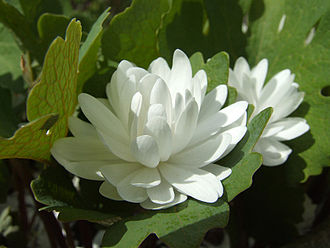Bloodroot
(Sanguinaria Canadensis) is a pretty little plant that’s native to North
America and blooms in spring from February to May. It’s also known as Canada
puccoon, bloodwort, and pauson. (I hadn't ever heard of puccoon or pauson. Those names may be more in use in Canada.)
In the
wild, it has white flowers with yellow centers and roundish, multi-lobed green
leaves. The flowers only last a few days, but the leaves form an attractive
carpet effect on the forest floor
The
showy double-petal version is used in ornamental garden plantings.
But beware!
The sap of both versions of this plant is blood-red and extremely toxic. It is especially
dangerous to dogs and cats, and herbivores generally avoid it.
Bloodroot
is found on the east coast of North America from Canada to Florida and its
habitat extends to the Mississippi.
The
Algonquin and other Native Americans used it for a dye, especially for baskets,
and in various medicines.
The
plant produces a toxin called sanguinarine. It’s found mostly in the rhizome root
structure, which is sweet-potato orange when cut open. But the sap is so
caustic it burns the skin on contact. In folk medicine, it was used as an antiseptic,
and also to burn off warts and tumors.
Charlatans
hawked a tincture of sanguinarine as a cancer cure, and “black salve” was sold
widely as a cure for various skin ailments.
It is still available on the Internet, but is not recommended by the
medical community.
It’s been
used in various types of medical quackery since the early 1800s.
In the
mid 19th century four patients at Bellevue Hospital in New York died
after drinking sanguinaria tincture they mistook for a more benign alcoholic
beverage.
A
cure-all called “Dr. Pinkard's Sanguinaria Compound” was sold as a “nerve
tonic” that was supposed to cure everything from pneumonia to hepatitis, It's inventor, herbalist John Henry Pinkard was convicted in 1931 on charges of misrepresenting
its powers, but due to his standing in the community, his fine was only $25.
Sanguinaria
is used more efficaciously to induce vomiting, reduce inflammation, and calm
tooth pain. In toothpaste, it is said to reduce plaque and bacteria. Until
2001, it was an ingredient in an anti-plaque toothpaste called Viadent, which I
used in the 1980s. Unfortunately, it was linked to a kind of oral cancer called
leukoplakia, so it is no longer an ingredient in Viadent.
But
other toothpastes do use it, so check the ingredients of your toothpaste
carefully.
Bloodroot
is also still used in “holistic” medicine, but users should be aware that long
term use or overdose is dangerous and can be fatal.
If you're writing a mystery with a character who’s trying to kill off an eccentric herbalist or holistic practitioner, an overdose of bloodroot might do the trick and look like an accidental incident.
If you're writing a mystery with a character who’s trying to kill off an eccentric herbalist or holistic practitioner, an overdose of bloodroot might do the trick and look like an accidental incident.
Although bloodroot
and bloodroot tincture probably wouldn’t make ideal murder weapons, since
sanguinaria is so caustic it immediately causes drooling, vomiting, eye
irritation, dizziness and convulsions, which would signal the need for urgent medical attention.
If the
victim gets to a doctor, fluid therapy can flush the toxin out and an
antiemetic can keep vomiting under control.
But untreated, the body will go into a coma. Death from organ failure soon follows.
But untreated, the body will go into a coma. Death from organ failure soon follows.
Have you ever used a medicine that contained bloodroot? Do you know any stories that involve bloodroot poisoning?
Here's a list of all the poisons in this series
.jpeg/330px-Bloodroot_(Sanguinaria_canadensis).jpeg)



Wow - I'm wondering how the Native Americans used it as a dye without getting it on their skin. Interesting.
ReplyDeletePatricia--I have to assume they used knives and sticks to they wouldn't have to touch it. I think they made a bath of it and soaked the reeds they would make into baskets. But it must have been dangerous. Probably required a long apprenticeship to learn how to do it properly.
DeleteI had hoped to copy your poison listing (overview), but found it discontinued? Gotta research later, as I am busy.
ReplyDeleteThank you, for all you share freely!